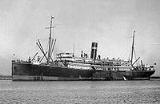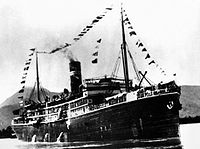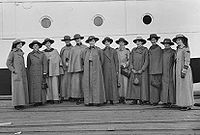
TSS Kanowna
Encyclopedia
TSS Kanowna, was an Australia
Australia
Australia , officially the Commonwealth of Australia, is a country in the Southern Hemisphere comprising the mainland of the Australian continent, the island of Tasmania, and numerous smaller islands in the Indian and Pacific Oceans. It is the world's sixth-largest country by total area...
n steamer
Steamboat
A steamboat or steamship, sometimes called a steamer, is a ship in which the primary method of propulsion is steam power, typically driving propellers or paddlewheels...
built during 1902. The 6,993-ton, 126 metres (413.4 ft) long Kanowna was constructed by William Denny and Brothers
William Denny and Brothers
William Denny and Brothers Limited, and often referred to simply as Denny, were a Scottish shipbuilding company.-History:The Company was founded by Peter Denny in 1840 and based in Dumbarton, on the River Clyde. Although the Denny yard was situated near the junction of the River Clyde and the River...
of Dumbarton, Scotland
Scotland
Scotland is a country that is part of the United Kingdom. Occupying the northern third of the island of Great Britain, it shares a border with England to the south and is bounded by the North Sea to the east, the Atlantic Ocean to the north and west, and the North Channel and Irish Sea to the...
, and had a twin screw
Twin screw steamer
A twin screw steamer is a steam-powered vessel propelled by two screws, one on either side of the plane of the keel....
design.
Operational history
Kanowna was operated by the Australian United Steam Navigation CompanyAustralian United Steam Navigation Company
The Australian United Steam Navigation Company was a shipping company of Australia from 1887 to 1961. It was formed through the amalgamation of the Australasian Steam Navigation Company and the Queensland Steam Shipping Company with their respective vessels in 1887....
(AUSNC), and it served the Sydney
Sydney
Sydney is the most populous city in Australia and the state capital of New South Wales. Sydney is located on Australia's south-east coast of the Tasman Sea. As of June 2010, the greater metropolitan area had an approximate population of 4.6 million people...
to Fremantle
Fremantle, Western Australia
Fremantle is a city in Western Australia, located at the mouth of the Swan River. Fremantle Harbour serves as the port of Perth, the state capital. Fremantle was the first area settled by the Swan River colonists in 1829...
route.

Troopship
A troopship is a ship used to carry soldiers, either in peacetime or wartime...
1,000 soldiers to German New Guinea
German New Guinea
German New Guinea was the first part of the German colonial empire. It was a protectorate from 1884 until 1914 when it fell to Australia following the outbreak of the First World War. It consisted of the northeastern part of New Guinea and several nearby island groups...
as part of the Australian Naval and Military Expeditionary Force
Australian Naval and Military Expeditionary Force
The Australian Naval and Military Expeditionary Force was a small volunteer force of approximately 2,000 men, raised in Australia shortly after the outbreak of the First World War to seize and destroy German wireless stations in German New Guinea in the south-west Pacific...
. Sailing late from Townsville on 8 August, the ship was forced to anchor off Thursday Island until 16 August, and did not arrive off Port Moresby
Port Moresby
Port Moresby , or Pot Mosbi in Tok Pisin, is the capital and largest city of Papua New Guinea . It is located on the shores of the Gulf of Papua, on the southeastern coast of the island of New Guinea, which made it a prime objective for conquest by the Imperial Japanese forces during 1942–43...
until 6 September. The expeditionary force sailed the next day for Rabaul, but Kanowna fell behind the rest of the convoy, with the ship's master signalling to that his crew had mutinied
Mutiny
Mutiny is a conspiracy among members of a group of similarly situated individuals to openly oppose, change or overthrow an authority to which they are subject...
: the boiler stokers and firemen had stopped work. In Arthur Jose
Arthur Wilberforce Jose
Arthur Wilberforce Jose was an English-Australian historian and editor of the Australian Encyclopaedia.Jose was born at Bristol, South West England, eldest son of William Wilberforce Jose, , and his wife Sarah Maria, née Woodward. W. W...
's Royal Australian Navy
Royal Australian Navy
The Royal Australian Navy is the naval branch of the Australian Defence Force. Following the Federation of Australia in 1901, the ships and resources of the separate colonial navies were integrated into a national force: the Commonwealth Naval Forces...
-focused volume of the Official History of Australia in the War of 1914–1918, he claims that the mutiny was because these men refused to leave Australian waters, but Tom Frame
Tom Frame (bishop)
Tom Frame is an Australian Anglican bishop, historian, academic, author and social commentator.Frame was born in Stanmore, New South Wales and raised in Wollongong by his adoptive parents.-Career:...
and Kevin Baker state in Mutiny! that this is incorrect; the troopship was on short rations of food and water because of the delays sailing north and only minimal resupply in Port Moresby, but the stokers and firemen were requesting more water to remain hydrated in the hot boilerrooms and to wash off coal grime, and refused to work until this demand was met. The workers were taken into the custody of a party of soldiers, and the force's commander ordered Kanowna to return to Townsville, with soldiers volunteering to keep the ship running. The Australian Commonwealth Naval Board
Australian Commonwealth Naval Board
The Australian Commonwealth Naval Board was the governing authority over the Royal Australian Navy from its inception and through World Wars I and II. The board was established on 1 March 1911 and consisted of civilian members of the Australian government as well as naval flag officers....
conducted an inquiry into the mutiny, even though as a civilian vessel, Kanowna technically wasn't under their jurisdiction. The state of the supplies was seen as a major contributing factor to the sailors' actions. Kanowna was returned to her owners on 21 September.
On 1 June 1915, the vessel was requisitioned again form military service. Kanwona transported soldiers and supplies to Egypt, then made for England, where she was modified for use as a hospital ship. After completion, Kanowna could carry 452 wounded in cots, along with a medical staff of 88 in addition to her regular crew. Sailing in September, Kanowna was used to transport Royal Army Medical Corps
Royal Army Medical Corps
The Royal Army Medical Corps is a specialist corps in the British Army which provides medical services to all British Army personnel and their families in war and in peace...
personnel to locations throughout the Mediterranean, then collected wounded Australian personnel and transported them home. This was the ship's role for the next four years, although some runs were made to England with British wounded. In May 1917, the unrestricted submarine warfare
Unrestricted submarine warfare
Unrestricted submarine warfare is a type of naval warfare in which submarines sink merchantmen without warning, as opposed to attacks per prize rules...
campaign forced the ship to sail around Africa instead of through the Mediterranean: the nurses and medical staff were transported overland from Durban to London, and used to supplement hospital personnel until Kanowna arrived in July. In October 1918, after the war's end, the hospital ship was sent to collect 900 British and Commonwealth prisoners-of-war that had been interred in Turkey. Kanowna was returned to the AUSNC on 29 July 1920, and she resumed passenger and cargo service.
Fate

Victoria (Australia)
Victoria is the second most populous state in Australia. Geographically the smallest mainland state, Victoria is bordered by New South Wales, South Australia, and Tasmania on Boundary Islet to the north, west and south respectively....
's largest shipwrecks.
The exact location of the shipwreck was unknown until 2005. On 23 April, four divers found a shipwreck 50 kilometres (31.1 mi) into Bass Strait
Bass Strait
Bass Strait is a sea strait separating Tasmania from the south of the Australian mainland, specifically the state of Victoria.-Extent:The International Hydrographic Organization defines the limits of the Bass Strait as follows:...
and submerged in approximately 80 metres (262.5 ft) of water, which was believed to be the former merchant ship. A more detailed inspection of the wreck site on 8 May allowed the divers to match the wreck with drawings
Technical drawing
Technical drawing, also known as drafting or draughting, is the act and discipline of composing plans that visually communicate how something functions or has to be constructed.Drafting is the language of industry....
of Kanowna.

